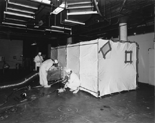


O'Brien & Gere won a Program Research and Development Announcement for a pilot-scale demonstration of the effectiveness of soda blasting to remove uranium isotopes, technetium-99, heavy metals, and PCBs on both concrete structures and metal equipment. The soda blasting system aimed abrasive sodium bicarbonate under pressure and at high speed at contaminated surfaces to mechanically remove surface contamination while leaving structures and equipment intact for further use.
The demonstration was conducted in building K-29, where a gaseous diffusion process separated uranium-235 from uranium ore for use in atomic weapons and commercial reactors. The project, conducted between December 1993 and September 1994, also included cleanup of the wastewater from the blasting operations.
Soda blasting test
 To meet health and
safety concerns during the soda blast, a blasting enclosure was
built to contain hazardous and radioactive waste. Blasting
personnel were fitted with special protective clothing and
supplied-air gear. The test was designed to evaluate the effects
of six variables on the operation of the blasting system.
To meet health and
safety concerns during the soda blast, a blasting enclosure was
built to contain hazardous and radioactive waste. Blasting
personnel were fitted with special protective clothing and
supplied-air gear. The test was designed to evaluate the effects
of six variables on the operation of the blasting system.
A concrete floor at K-29 was gridded into ten one-meter squares. Major contaminants for each square were recorded. After scouring with sodium bicarbonate, the contaminants in the squares were measured again to test the effectiveness of the soda blast. The soda blast was also used on such metal surfaces as an aluminum circuit breaker handle, steel trash can, and compressor blade.
For surfaces tested using selected blasting variables, test results showed contaminant removal averaged between 95 and 100 percent for beta/gamma radioactivity and between 0 and 100 percent for alpha radioactivity. The lower percent removal for alpha was caused by pre-blast readings approaching background levels. In each test, the post-blast alpha readings were below the release limit of 5,000 disintegrations per minute (dpm).
After each blasting test, the tested surfaces were hosed down with tap water to remove the loosened waste. The surfaces were then vacuumed with a wet/dry vacuum and the resulting slurry (water, used sodium bicarbonate, and hazardous and radioactive waste) was transferred to 55 gallon drums in preparation for treatment.
Pretreatment of blasting residuals
Several physical methods were used to remove uranium, other heavy
metals, and PCBs from the slurry. The first step was the addition
of a 70 percent nitric acid solution to 450 gallons of blasting
residual. This nitric acid addition lowered the pH value and
facilitated the removal of aqueous phase carbon dioxide following
two hours of aeration. The pH level was then elevated by adding
sodium hydroxide, which facilitated the formation of insoluble
uranium and other heavy metal hydroxides, which settled to the
bottom of the holding tank and were removed. Unsettled
particulates were further treated by filtration. The last phase
of the pretreatment removed dissolved PCBs with an activated
carbon system.
The pilot pretreatment system effectively removed more than 97 percent of uranium and more than 99 percent of PCBs and lead. Also, 61 percent removal of technetium was achieved during pretreatment.
Technetium removal
Two technetium removal methods were tested. The first test
involved the setup of an ion exchange system employing
commercially available resins from Dow
Chemicals and Reilly Industries arranged in column beds.
During testing, 50 gallons of pretreated blasting residual
solution were processed through each column. Column effluents
were sampled at 30-minute time intervals. Analysis of the samples
demonstrated technetium removal below the 100 pCi/1 treatment
objective for both types of resins. However, the Dow resins were
more efficient in meeting the standard than were the Reilly
resins.
Removing technetium using a chemical reduction method did not prove effective.
Benefits
Soda blasting and the associated waste treatment system hold
promise as a surface decontamination method. Sodium bicarbonate
is non-toxic and water soluble. Its dissolution in water means it
is easily removed from contaminants, thus reducing waste volume.
Soda blasting is cost effective and energy efficient. The average
amount of sodium bicarbonate used was 1.39 pound per square foot
blasted. It is estimated approximately 1 pound per square foot
would be used during a full-scale decontamination. The volume of
waste generated during the demonstration project averaged 11.9
gallons per test grid. It is estimated the volume of waste
generated during full-scale decontamination would be
approximately 1.0 gallon per square foot. Treatment of the
residual waste achieved a significant 71 percent waste volume
reduction.
![]()